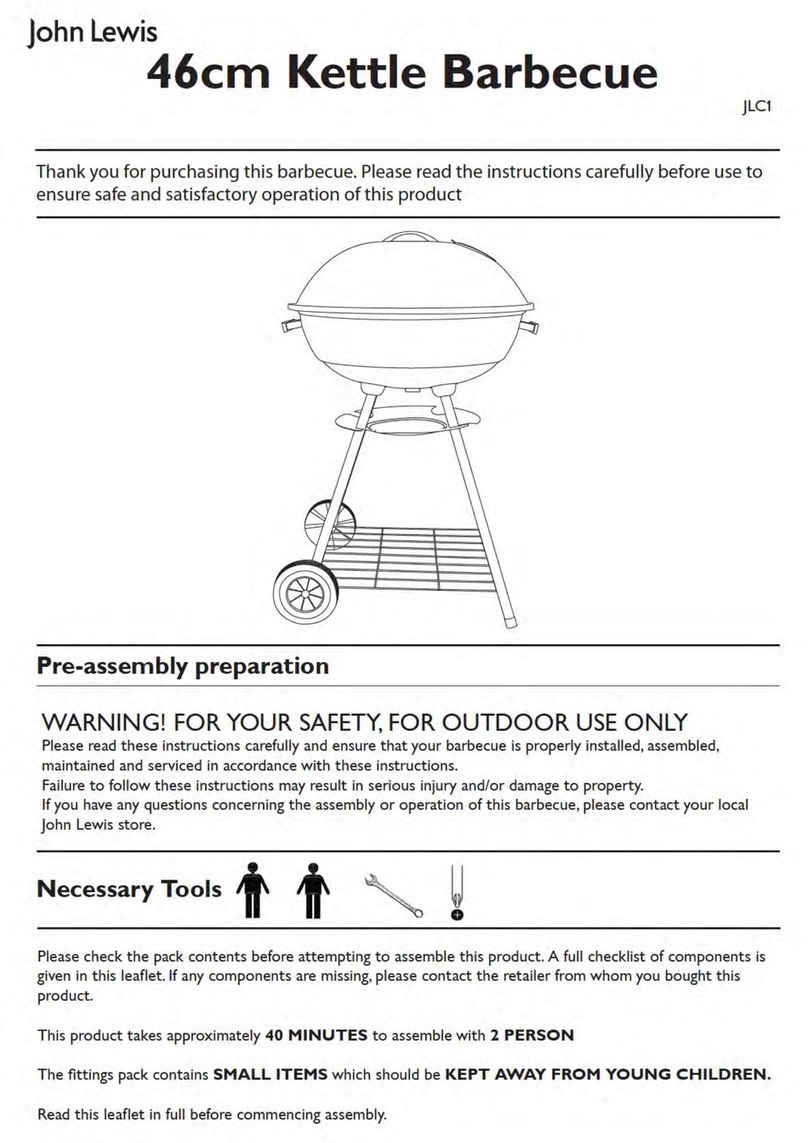
8
JLH2B5
-
-
Improper installation, adjustment, alteration, service or mainte
nance can cause injury or property damage. Read the instruc
tions thoroughly before installing this appliance. The installation
of your barbecue must meet all local codes and/or gas utility
requirements.
Keep any electrical supply cord and fuel supply hose away from
any heated surface.
Do not perform any servicing on the barbecue yourself. Call an
approved gas engineer.
It is important you install your barbecue exactly as described in
these instructions. In particular you should keep the barbecue
clear of combustible material, and you should check for leaks
whenever a new gas connection is made.
Do not leave the barbecue unattended. Keep children away
from the appliance at all times.
Keep the barbecue clean to avoid fat fires. FAT FIRES WILL
VOID ANY WARRANTY.
Note gas type: Within these instructions we make reference to
gas cylinders and regulators. This barbecue is suitable for
propane or butane gas. We recommend you use a 27mm clip on
propane gas bottle to enable barbecuing all year round.
The length of the hose must not exceed 1.5m. The hose should
not be twisted.
This appliance must be kept away from flammable materials
when in use.
There must be no obstruction to the ventilation of the barbe-
cue frame.
Changing the gas bottle MUST be carried out away from any
source of combustion and in accordance with the gas bottle
manufactures instructions.
FOR YOUR SAFETY
IF YOU SMELL GAS
1. Shut off gas to the appliance
2. Extinguish any open flames
3. Open lid
4. If odour continues, immediately call your gas
supplier or fire department.
FOR YOUR SAFETY
1. For outdoor use only
2. Do not store or use gasoline or other
Flammable vapours or liquids in the vicinity of
this or any other appliance.
3. An LP cylinder not connected for use shall
not be stored in the vicinity of this or any other
pipelines.
This barbecue must be installed according to these
Instructions.This appliance is for OUTDOOR USE ONLY.
Use in a well ventilated space only. This unit MUST NOT
be used in a building, garage or any other enclosed area.
This appliance should NOT be located under any
overhead, unprotected combustible construction. The
back, side and bottom of the barbecue should NOT be
any closer than 100mm to a combustible surface.
THIS OUTDOOR COOKING GAS APPLIANCE IS NOT
INTENDED TO BE INSTALLED IN OR ON
RECREATIONAL VEHICLES AND/OR BOATS.
Keep the area near your barbecue and cylinder clear of
debris and ensure that it is well ventilated.
Never place your barbecue near any combustible material,
gasoline or other flammable vapours or liquids.
Assemble according to 1-10 on pages 5-7
Check the gas type sticker attached to the barbecue.
Ensure the appliance supplied is suitable for the gas type
you require. Throughout Europe, barbecues use butane or
propane gas, please be aware that different types of gas
cylinder valves are in widespread use. The regulator must
be designed to fit the cylinder valve that you purchased.
Never attempt to force a quick-on connection regulator
onto a cylinder valve. It is much safer to contact your
barbecue supplier or gas supplier for assistance.
LP gas pressure regulators and hose assemblies must be
used without alteration.The hose must be inspected for
abrasion, wear or cuts prior to each use. If the hose or
regulator assembly needs to be replaced, use only the type
specified by the manufacturers of this appliance.
The regulation hose should be connected to the appliance
by fitting hose to the inlet connection. Please use a spanner
to ensure this conection is tight and no gas can escape.
Do not use thread tapes or sealers on these connections.
Safety information Installation
Where to put your barbecue
Assembly and gas connection





























